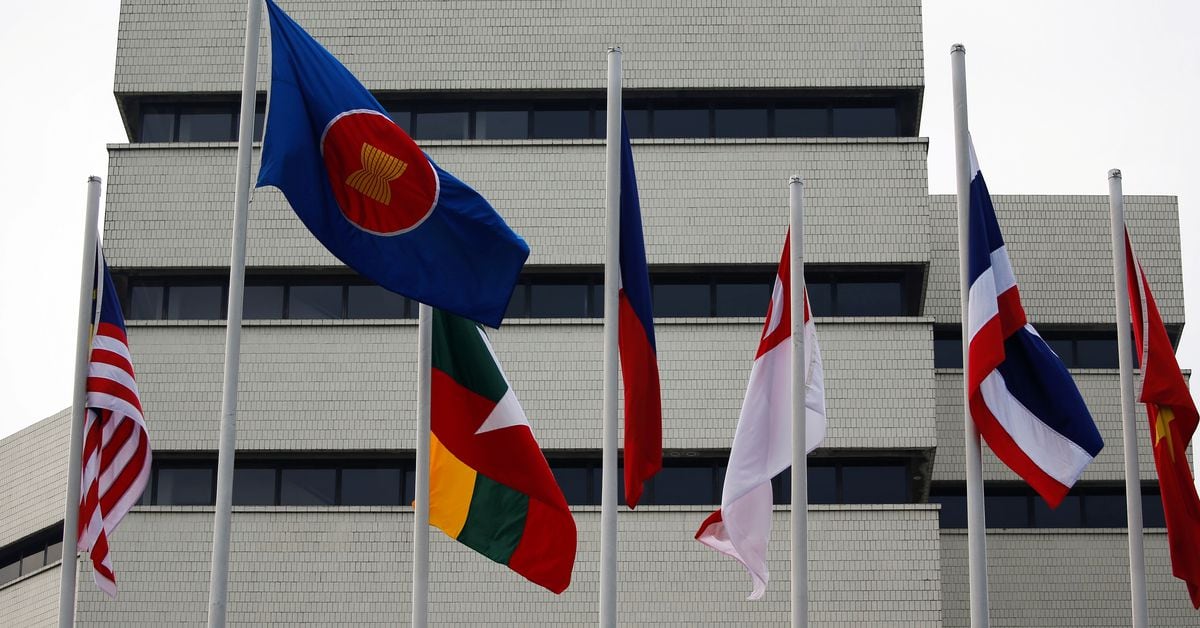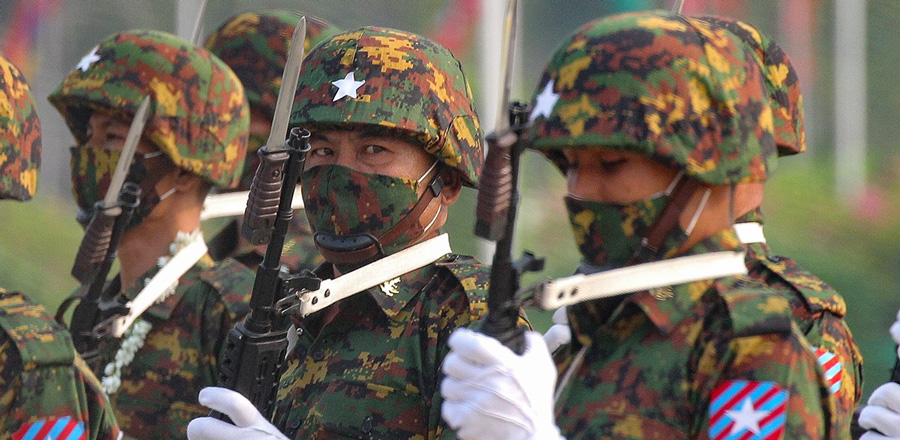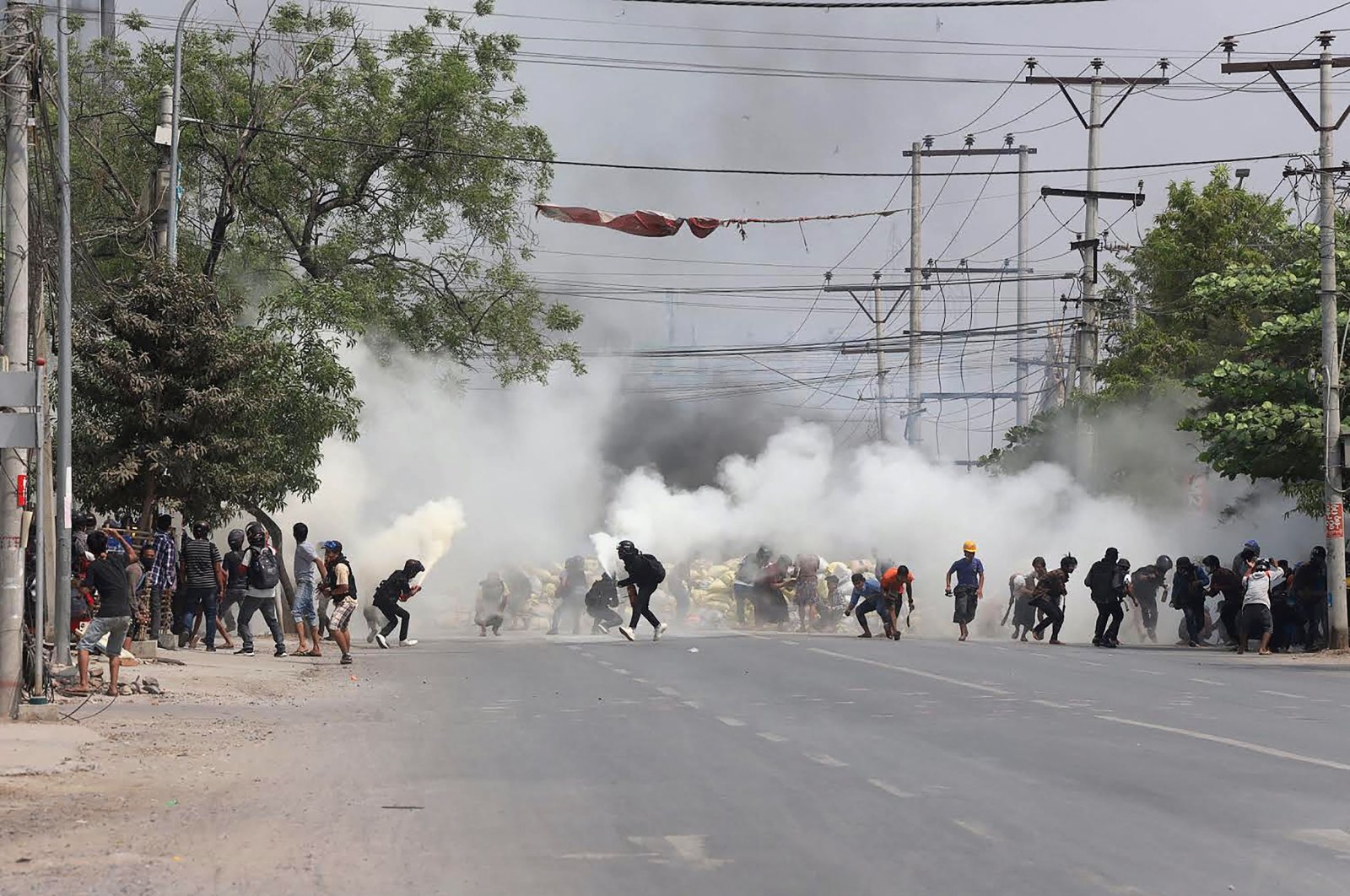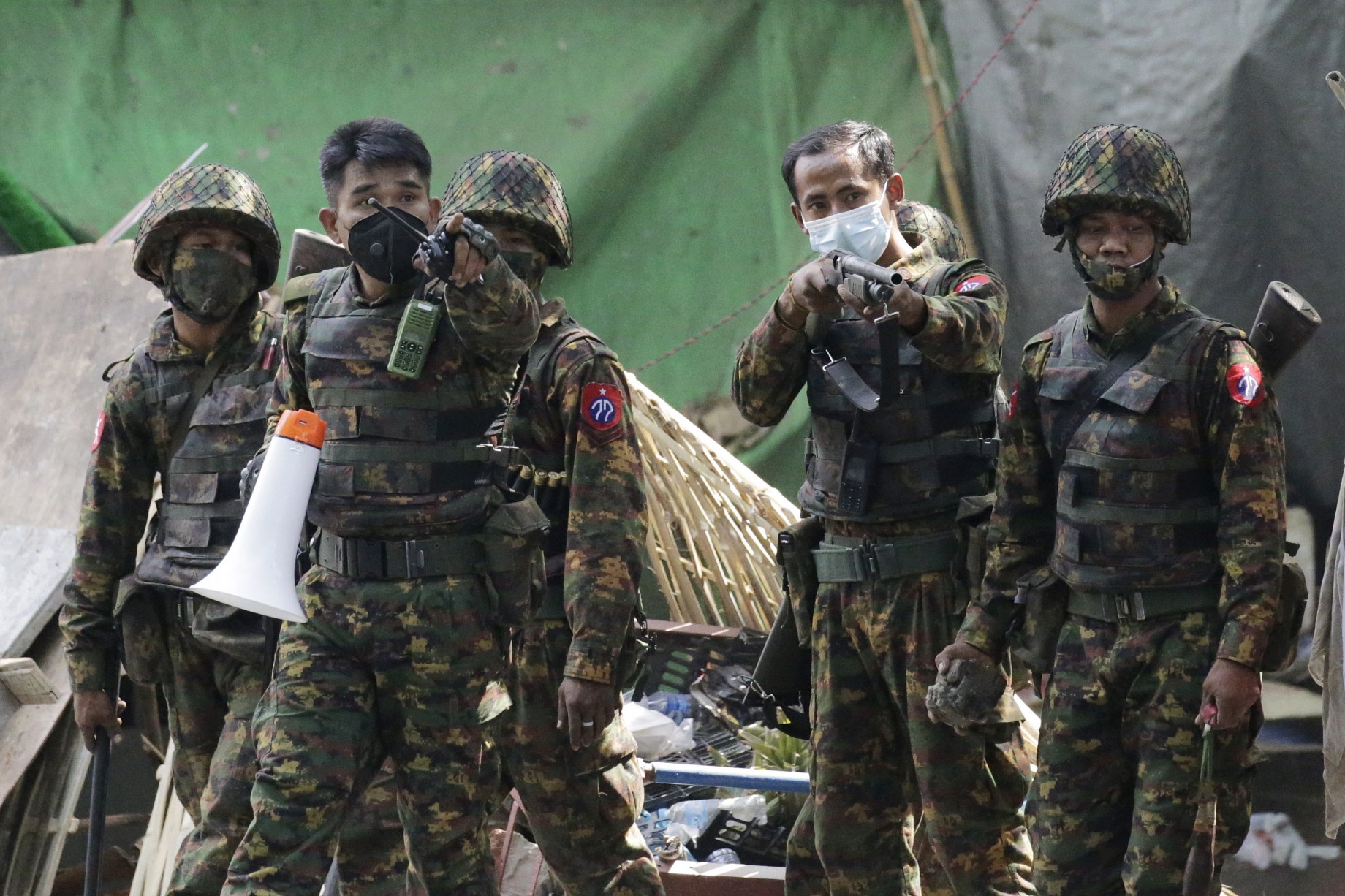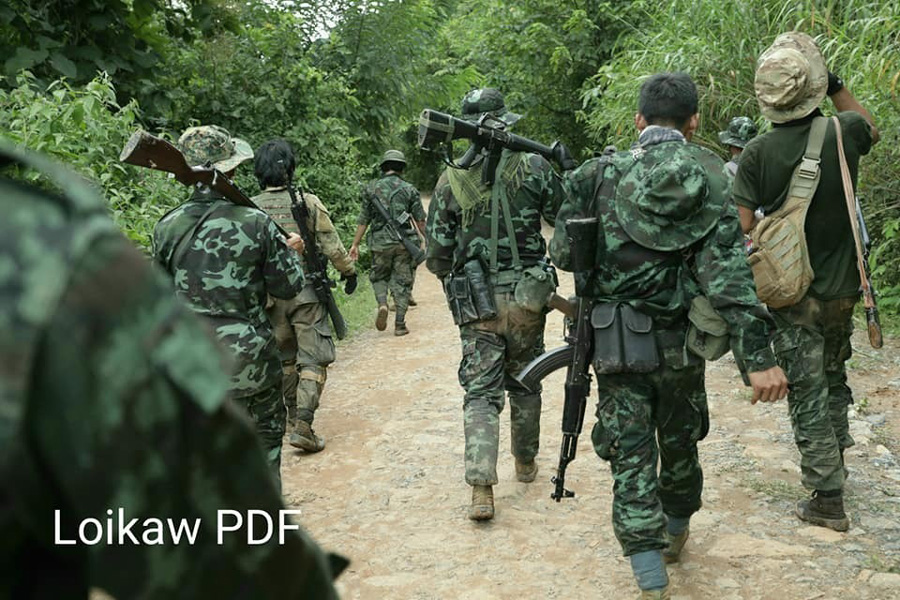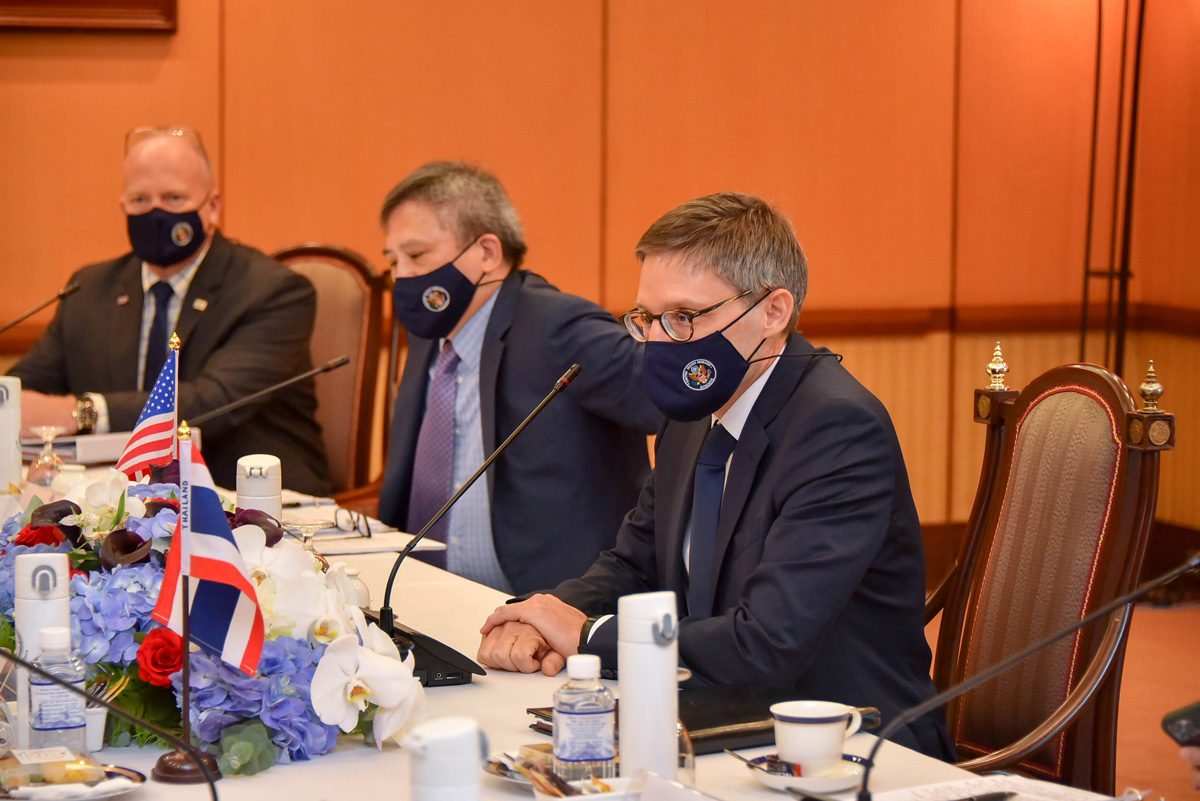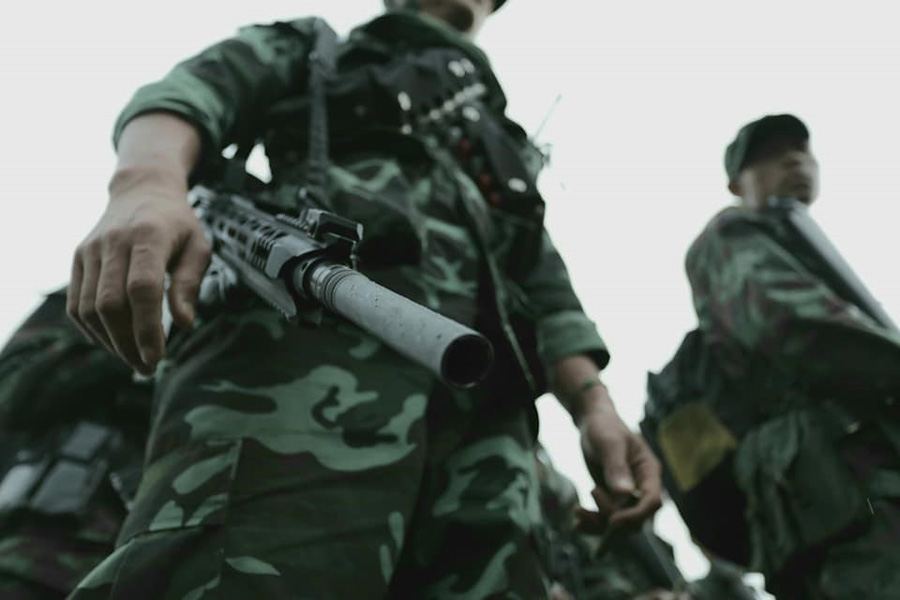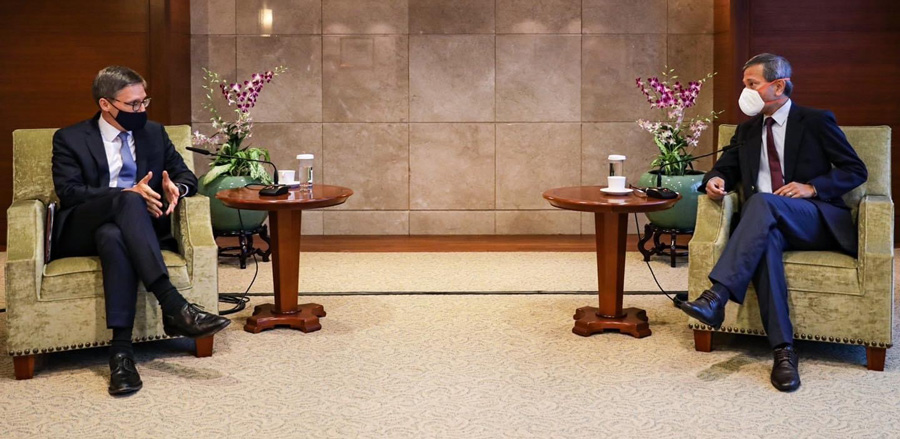Around 50 junta soldiers were reportedly killed between Wednesday and Friday in clashes with civilian resistance fighters in Mandalay, Sagaing, Yangon Regions and Kayah State.
People’s Defense Forces (PDF) across the country, with the exception of Rakhine State, have stepped up operations against the Myanmar military since September 7, when the parallel National Unity Government (NUG) declared a nationwide people’s defensive war against the junta.
On early Friday morning, a civilian armed force from Shwe Bo District in Sagaing Region claimed to have killed at least 12 junta soldiers in an ambush.
The group said that they attacked a regime column marching near Mon Taw Village in Khin-U Township with landmines.
Eight junta soldiers were also killed in Khin-U Township on Wednesday when two military vehicles were attacked with landmines near Myakan Village.
Around 10 junta soldiers were reported killed on Thursday afternoon after a combined force of 10 civilian armed groups mined two military vehicles in Myaung Township, Sagaing Region, according to a statement by the Civilian’s Defense and Security Organization of Myaung (CDSOM).
The same morning, two other military vehicles were also attacked with landmines by CDSOM. However, military casualties remain unknown.
Junta forces were also attacked in Natogyi and Kyaukse townships in Mandalay Region. Civilian fighters of the Zero Guerrilla Force raided regime troops deployed at a school in Suuphyukone Village, Natogyi Township on late Thursday night.
During the raid, the junta troops sleeping quarters were hit and at least 12 soldiers died and many others were injured, according to the Zero Guerilla Force.
Another PDF attacked junta troops traveling by train in Palate, Sintgaing Township in Mandalay Region. Some 10 junta soldiers were killed by landmines while they were inspecting the blast-affected train.
“The train is used by the junta for transporting food and supplies. Despite being a passenger train, everyone on the train was a junta soldier. No civilian passengers were on the train,” a resident told The Irrawaddy on Thursday.
One junta soldier was injured on Thursday morning when unknown gunmen opened fire from a vehicle on regime troops performing sentry duty near a bridge in Yangon’s North Okkalapa Township, according to a statement from the NUG’s Defense Ministry.
Three junta soldiers were killed and four injured on Thursday morning in Kayah State, when fighters from the Karenni Nationalities Defense Force (KNDF) ambushed junta troops travelling to raid civilian resistance groups in Demoso Township.
The shootout between the two forces continued into the afternoon, with regime soldiers using heavy weapons and torching homes in nearby villages.
A clash between junta troops and the Karenni Army (KA), the armed wing of the Karenni National Progressive Party, also occurred in Hpasawng Township, Kayah State on Thursday evening, according to the KNDF.
Myanmar’s military has escalated its raids and acts of violence, including burning down villages and bombarding residential areas of towns, in the country’s most restive regions, including Magwe and Sagaing regions and Chin and Kayah States.
As of Thursday, 1,171 people have been slain by junta forces during their raids, crackdowns, arrests, interrogations and arbitrary killings, said the Assistance Association for Political Prisoners.
Another 8,981 people, including elected government leaders, have been detained by the junta or face arrest warrants.
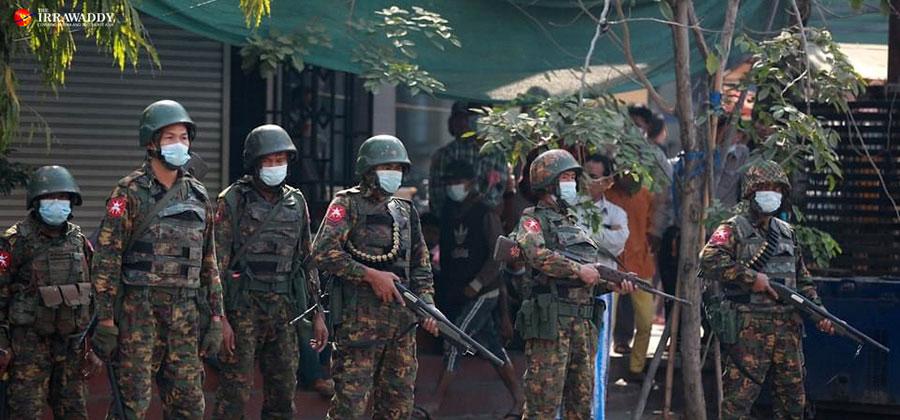
 www.irrawaddy.com
www.irrawaddy.com
Last month, Myanmar soldiers gunned down Cung Biak Hum, a 31-year-old Baptist pastor, while he rushed to help put out a fire caused by military shelling. As his town of Thantlang in Myanmar’s northwestern Chin State went up in flames, soldiers sawed off the pastor’s finger and stole his wedding ring.
“The killing of Cung Biak Hum and mutilation of his finger demonstrate the extent of disrespect and brutality with which [Myanmar military] soldiers are conducting themselves in their ongoing war against the people,” Salai Za Uk Ling, deputy director of the Chin Human Rights Organisation, told Al Jazeera.
The September 19 incident is one of at least 20 cases documented by human rights groups and the media, in which Christian churches, church leaders and volunteers have been targeted or caught in the crossfire of military attacks since a February 1 coup.
The incidents include shelling churches, detaining pastors, and using churches as military bases.
“Churches are now empty and deserted,” said a Catholic church leader in Kayah State who, like several others interviewed for this article, spoke on condition of anonymity due to concerns of reprisals. “Fear is instilled in the hearts of people. Even churches are not safe from attacks,” he said.
Military spokesman Major General Zaw Min Tun did not respond to multiple attempts to reach him for comment on the incidents mentioned in this report, as his phone was switched off.
In May, the military justified its attacks on churches in Kayah, including a Catholic church where artillery fire killed four people, by claiming “local rebels” were hiding there, Radio Free Asia reported.
According to 2014 census figures, which surveyed some 50 million people and excluded roughly 1 million mostly Muslim Rohingya, Myanmar’s population is nearly 90 percent Buddhist.
The predominantly Buddhist ethnic Bamar majority dominates the military and politics, and the military has long promoted Buddhist nationalist organisations. The military-drafted 2008 constitution also recognises the “special position of Buddhism as the faith possessed by the great majority of the citizens”.
Christians, meanwhile, make up just six percent of Myanmar’s population and are mostly from ethnic minorities concentrated along the country’s borders, where their experiences of marginalisation and forced assimilation have contributed to decades-long armed struggles for self-determination.
According to Benedict Rogers, senior analyst for East Asia at the human rights organisation Christian Solidarity Worldwide and author of three books on Myanmar, the military has always had a “deep-seated hostility” towards non-Buddhist religious minorities.
“[The military] have often used religion as a tool of repression. They have sowed religious nationalism, and that has been the case for decades,” he said, adding that since the coup, these patterns have only intensified. “Christians have certainly been targeted, both for their religion and their ethnicity,” he told Al Jazeera.
Chin, Kayah and Kachin State have the country’s largest concentration of Christians, according to the census.
Some 85 percent of the 478,000 residents of Chin State, located on Myanmar’s northwestern border with India, identified as Christian, while in Kayah, which borders Thailand in Myanmar’s southeast, 46 percent of its 286,000 people said they were Christian.
In Kachin State, in Myanmar’s far north on the border with China, 34 percent of 1.6 million people surveyed identified as Christian; the census excluded about 46,000 people living in areas under the control of the Kachin Independence Organisation.
“[The central government] set the mark of their ownership on Kachin lands, building their pagodas wherever there is a hill,” said Layang Seng Ja, head of research and publications and a professor at the Kachin Theological College and Seminary. “Our beautiful hills, valleys, plains and mountains have the symbols of their domination.”
Security forces have killed more than 1,100 unarmed civilians, according to rights groups, mostly during street demonstrations, and as people have increasingly taken up arms, the military has indiscriminately attacked entire civilian populations, following a ‘four cuts’ strategy it has applied for decades in ethnic areas.
In Kayah and southern Shan State, more than 100,000 people have fled their homes since an intense military offensive began in May.
At least five churches have been damaged in artillery fire, including the Sacred Heart of Jesus Catholic church in Kayah’s Loikaw township where four civilians were killed.
About 300 people from the township’s South Kayantharyar village sought shelter in the church grounds on May 22, hiding in two cathedrals and the priests’ residence. “It seemed like the war was closing in on us, and we thought that the church would be safe,” said Khu Reh, a farmer. Al Jazeera has used a pseudonym for the 56-year-old.
The villagers raised white flags around the compound’s perimeter as a gesture of peace. They also disposed of kitchen knives and other items that could be mistaken for weapons, said Khu Reh.
According to his account, soldiers arrived the next day, searching the church grounds and questioning the villagers. “They warned us not to leave the church, and said that if they saw anyone coming out, they would shoot,” he said.
That night, he and a handful of villagers stood guard at the church gates.
One of them, he said, was shot in the leg at about 9pm local time (14:30 GMT). Artillery fire began falling on the village and two nearby villages at 1am (18:30 GMT), and when it stopped two hours later, Khu Reh and the other guards opened the doors to the new cathedral to a billow of smoke. Three elderly women and an elderly man lay dead and eight people were injured.
When Khu Reh returned the next day, he found the church ransacked and looted. “After that, whenever [soldiers] came to our village, they always stationed at our church,” said Khu Reh, who along with others from his village has since been living in a displacement camp.
The Catholic church leader interviewed by Al Jazeera said that soldiers have also stationed themselves at the Doumyalay Parish Church in Loikaw township, and on May 29 entered the compound of St. Peter’s seminary – also in Loikaw township – where 1,300 people had taken shelter, and shot a volunteer dead.
On Wednesday, a Catholic church in Kayah State’s Hpruso township was damaged by artillery fire; the clashes are ongoing, said the Catholic church leader.
He added that soldiers have confiscated medicine and food supplies which church groups had collected for displaced people, following patterns of aid obstruction which media and rights groups have documented across the country.
Although he risks his life to do so, the church leader says he remains committed to protecting and helping civilians in need.
“Humanitarian concern, human dignity and value, and compassionate hearts make us see [all civilians] as our brothers and sisters in need,” he said. “We must be with them in their fear and protect them. The suffering of our people is our suffering. The cries of our people are our pain.”
In August, soldiers passed through the Taal Baptist Church in Falam township and left Bibles and hymn books strewn outside the church amid piles of rubbish, according to photos seen by Al Jazeera.
And on October 3, local media outlet Zalen reported that soldiers entered a Catholic church in Magway region where displaced villagers from Mindat township had taken shelter. Soldiers interrogated them and checked their phones for evidence of ties to armed resistance, according to the report. Zalen also reported on Wednesday that soldiers had set a church in Chin State’s Falam township on fire as it burned and looted a small village. Al Jazeera was unable to independently verify these reports.
A representative from the Chin Baptist Convention, who spoke on condition of anonymity, told Al Jazeera that soldiers also destroyed Bibles while occupying the Grace Baptist Church in Mindat township in August. “The coup has affected our ability to safely and freely worship,” he said. “People worry that they will be attacked or bombed while they are praying.”
The violence, arrests and other forms of persecution which Christian churches across Myanmar have faced since the coup were already being acutely felt in the country’s far north, where a ceasefire between the Kachin Independence Organization and the military collapsed in 2011.
In 2015, two volunteer teachers from the Kachin Baptist Convention were raped and murdered near a military encampment in northern Shan State, in a case which was never brought to justice.
And in 2017, two Baptist leaders were jailed on charges of defamation and supporting the KIO after they took journalists to a church which had been damaged by military airstrikes.
The military also threatened defamation charges against Kachin Baptist Convention president Hkalam Samson in 2019, after he told Donald Trump during a religious freedom event at the Oval Office that Christians in Myanmar had been “oppressed and tortured” by the military and lacked religious freedom.
Kachin churches have been integral in the humanitarian response to armed conflict, but have faced ongoing scrutiny for their humanitarian work, especially in KIO-controlled areas, where international aid access has effectively been blocked since 2016.
In 2018, the Kachin Baptist Convention had to temporarily suspend humanitarian operations in these areas after the military accused it of supporting the KIO because of its work.
Since the coup, fighting has increased between the KIO and military, and at least 14,000 people have been displaced, in addition to more than 100,000, who were already living in camps.
A Catholic church leader in Bhamo district, which has seen some of the most intense fighting, told Al Jazeera that the church’s humanitarian volunteers are regularly stopped at checkpoints, while in May, a Catholic priest was detained for four days while travelling from Bhamo to the state capital.
“[Soldiers] doubt us when we transport humanitarian aid, and we cannot transport it to displaced people when they need it,” said the church leader, who spoke on condition of anonymity.
It is among numerous ways that Kachin churches have been caught up in the post-coup crisis.
On March 8, a Catholic nun in the Kachin State capital knelt in front of police and soldiers and begged them to show mercy towards a group of protesters who had gathered in front of her church; she also served as a first responder that day when security forces opened fire, killing two.
In March and April, four Kachin churches were raided. At one of them, a Baptist church in northern Shan State, 30 soldiers entered, firing gunshots and detaining 10 people, including four ministers, for two days, according to local media reports.
The Kachin Theological College and Seminary in the state capital was also raided on March 13. According to Layang Seng Ja, a convoy of 15 military vehicles surrounded the campus and soldiers searched the grounds and dormitories. The school has since sent its students home, she said.
“If [soldiers] see people gathering, they will think somehow they are planning to do an uprising,” said the professor at the college, who herself fled to the KIO headquarters due to fear of arrest. “I want to go back to the classroom and teach my students about Jesus’ peace and justice, love and compassion, but I cannot do so now,” she added.
The military has also kept a close watch on Kachins’ prayer services. Three pastors in the state’s Nawngmun township have been in detention since June 14, under charges of incitement for allegedly using the phrase “ending military dictatorship” during a prayer for peace.
And on August 26, plainclothes police searched the Kachin Baptist Convention headquarters, alleging that the church’s secretary signed off on a COVID-19 prayer statement which used the phrase “terrorist junta”; The church claims the phrase was mistranslated from Kachin to Burmese.
“[The military] check the contents of our prayers,” said Seng Ja. “We cannot practice freedom of religion in our own land; we cannot talk about peace [or] justice.”
“We are in a living hell caused by this military junta and their mentality,” she added.
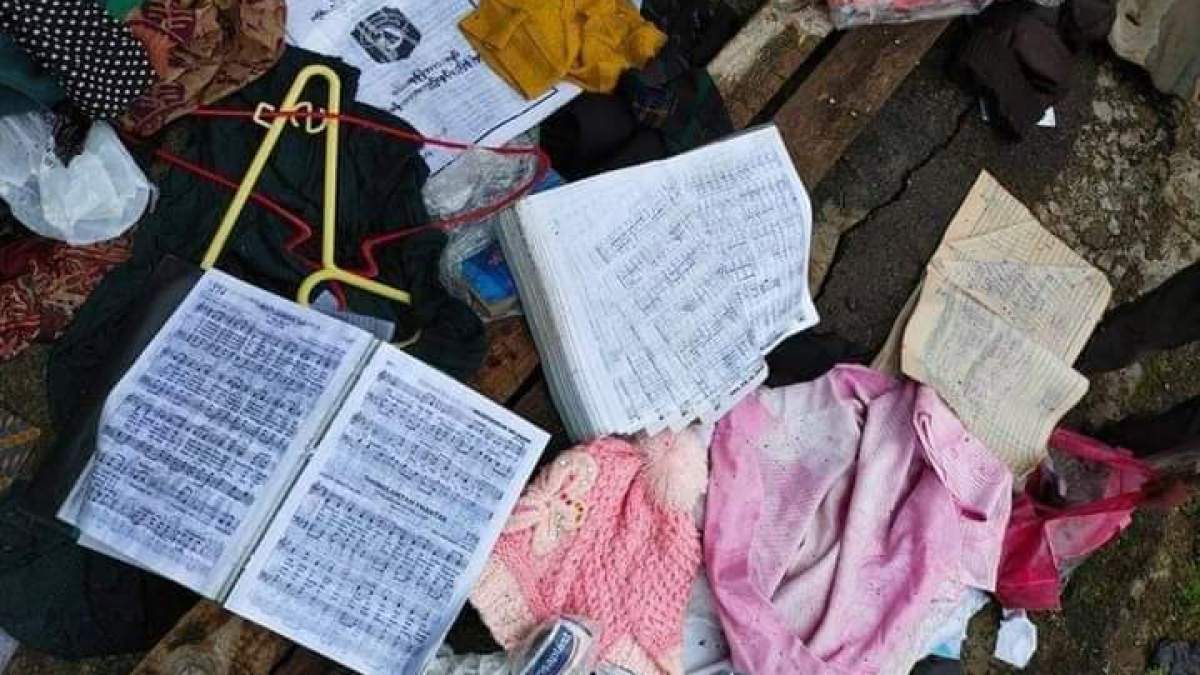
 www.aljazeera.com
www.aljazeera.com
People’s Defense Forces (PDF) across the country, with the exception of Rakhine State, have stepped up operations against the Myanmar military since September 7, when the parallel National Unity Government (NUG) declared a nationwide people’s defensive war against the junta.
On early Friday morning, a civilian armed force from Shwe Bo District in Sagaing Region claimed to have killed at least 12 junta soldiers in an ambush.
The group said that they attacked a regime column marching near Mon Taw Village in Khin-U Township with landmines.
Eight junta soldiers were also killed in Khin-U Township on Wednesday when two military vehicles were attacked with landmines near Myakan Village.
Around 10 junta soldiers were reported killed on Thursday afternoon after a combined force of 10 civilian armed groups mined two military vehicles in Myaung Township, Sagaing Region, according to a statement by the Civilian’s Defense and Security Organization of Myaung (CDSOM).
The same morning, two other military vehicles were also attacked with landmines by CDSOM. However, military casualties remain unknown.
Junta forces were also attacked in Natogyi and Kyaukse townships in Mandalay Region. Civilian fighters of the Zero Guerrilla Force raided regime troops deployed at a school in Suuphyukone Village, Natogyi Township on late Thursday night.
During the raid, the junta troops sleeping quarters were hit and at least 12 soldiers died and many others were injured, according to the Zero Guerilla Force.
Another PDF attacked junta troops traveling by train in Palate, Sintgaing Township in Mandalay Region. Some 10 junta soldiers were killed by landmines while they were inspecting the blast-affected train.
“The train is used by the junta for transporting food and supplies. Despite being a passenger train, everyone on the train was a junta soldier. No civilian passengers were on the train,” a resident told The Irrawaddy on Thursday.
One junta soldier was injured on Thursday morning when unknown gunmen opened fire from a vehicle on regime troops performing sentry duty near a bridge in Yangon’s North Okkalapa Township, according to a statement from the NUG’s Defense Ministry.
Three junta soldiers were killed and four injured on Thursday morning in Kayah State, when fighters from the Karenni Nationalities Defense Force (KNDF) ambushed junta troops travelling to raid civilian resistance groups in Demoso Township.
The shootout between the two forces continued into the afternoon, with regime soldiers using heavy weapons and torching homes in nearby villages.
A clash between junta troops and the Karenni Army (KA), the armed wing of the Karenni National Progressive Party, also occurred in Hpasawng Township, Kayah State on Thursday evening, according to the KNDF.
Myanmar’s military has escalated its raids and acts of violence, including burning down villages and bombarding residential areas of towns, in the country’s most restive regions, including Magwe and Sagaing regions and Chin and Kayah States.
As of Thursday, 1,171 people have been slain by junta forces during their raids, crackdowns, arrests, interrogations and arbitrary killings, said the Assistance Association for Political Prisoners.
Another 8,981 people, including elected government leaders, have been detained by the junta or face arrest warrants.

50 Myanmar Regime Soldiers Reported Killed in Clashes
The Myanmar military continues to take heavy casualties in fighting with civilian resistance groups across the country.
Last month, Myanmar soldiers gunned down Cung Biak Hum, a 31-year-old Baptist pastor, while he rushed to help put out a fire caused by military shelling. As his town of Thantlang in Myanmar’s northwestern Chin State went up in flames, soldiers sawed off the pastor’s finger and stole his wedding ring.
“The killing of Cung Biak Hum and mutilation of his finger demonstrate the extent of disrespect and brutality with which [Myanmar military] soldiers are conducting themselves in their ongoing war against the people,” Salai Za Uk Ling, deputy director of the Chin Human Rights Organisation, told Al Jazeera.
The September 19 incident is one of at least 20 cases documented by human rights groups and the media, in which Christian churches, church leaders and volunteers have been targeted or caught in the crossfire of military attacks since a February 1 coup.
The incidents include shelling churches, detaining pastors, and using churches as military bases.
“Churches are now empty and deserted,” said a Catholic church leader in Kayah State who, like several others interviewed for this article, spoke on condition of anonymity due to concerns of reprisals. “Fear is instilled in the hearts of people. Even churches are not safe from attacks,” he said.
Military spokesman Major General Zaw Min Tun did not respond to multiple attempts to reach him for comment on the incidents mentioned in this report, as his phone was switched off.
In May, the military justified its attacks on churches in Kayah, including a Catholic church where artillery fire killed four people, by claiming “local rebels” were hiding there, Radio Free Asia reported.
According to 2014 census figures, which surveyed some 50 million people and excluded roughly 1 million mostly Muslim Rohingya, Myanmar’s population is nearly 90 percent Buddhist.
The predominantly Buddhist ethnic Bamar majority dominates the military and politics, and the military has long promoted Buddhist nationalist organisations. The military-drafted 2008 constitution also recognises the “special position of Buddhism as the faith possessed by the great majority of the citizens”.
Christians, meanwhile, make up just six percent of Myanmar’s population and are mostly from ethnic minorities concentrated along the country’s borders, where their experiences of marginalisation and forced assimilation have contributed to decades-long armed struggles for self-determination.
According to Benedict Rogers, senior analyst for East Asia at the human rights organisation Christian Solidarity Worldwide and author of three books on Myanmar, the military has always had a “deep-seated hostility” towards non-Buddhist religious minorities.
“[The military] have often used religion as a tool of repression. They have sowed religious nationalism, and that has been the case for decades,” he said, adding that since the coup, these patterns have only intensified. “Christians have certainly been targeted, both for their religion and their ethnicity,” he told Al Jazeera.
Chin, Kayah and Kachin State have the country’s largest concentration of Christians, according to the census.
Some 85 percent of the 478,000 residents of Chin State, located on Myanmar’s northwestern border with India, identified as Christian, while in Kayah, which borders Thailand in Myanmar’s southeast, 46 percent of its 286,000 people said they were Christian.
In Kachin State, in Myanmar’s far north on the border with China, 34 percent of 1.6 million people surveyed identified as Christian; the census excluded about 46,000 people living in areas under the control of the Kachin Independence Organisation.
“[The central government] set the mark of their ownership on Kachin lands, building their pagodas wherever there is a hill,” said Layang Seng Ja, head of research and publications and a professor at the Kachin Theological College and Seminary. “Our beautiful hills, valleys, plains and mountains have the symbols of their domination.”
Crackdown on resistance
Military violence towards Christians since the coup comes amid a broader crackdown on the resistance movement which has swept the country.Security forces have killed more than 1,100 unarmed civilians, according to rights groups, mostly during street demonstrations, and as people have increasingly taken up arms, the military has indiscriminately attacked entire civilian populations, following a ‘four cuts’ strategy it has applied for decades in ethnic areas.
In Kayah and southern Shan State, more than 100,000 people have fled their homes since an intense military offensive began in May.
At least five churches have been damaged in artillery fire, including the Sacred Heart of Jesus Catholic church in Kayah’s Loikaw township where four civilians were killed.
About 300 people from the township’s South Kayantharyar village sought shelter in the church grounds on May 22, hiding in two cathedrals and the priests’ residence. “It seemed like the war was closing in on us, and we thought that the church would be safe,” said Khu Reh, a farmer. Al Jazeera has used a pseudonym for the 56-year-old.
The villagers raised white flags around the compound’s perimeter as a gesture of peace. They also disposed of kitchen knives and other items that could be mistaken for weapons, said Khu Reh.
According to his account, soldiers arrived the next day, searching the church grounds and questioning the villagers. “They warned us not to leave the church, and said that if they saw anyone coming out, they would shoot,” he said.
That night, he and a handful of villagers stood guard at the church gates.
One of them, he said, was shot in the leg at about 9pm local time (14:30 GMT). Artillery fire began falling on the village and two nearby villages at 1am (18:30 GMT), and when it stopped two hours later, Khu Reh and the other guards opened the doors to the new cathedral to a billow of smoke. Three elderly women and an elderly man lay dead and eight people were injured.
When Khu Reh returned the next day, he found the church ransacked and looted. “After that, whenever [soldiers] came to our village, they always stationed at our church,” said Khu Reh, who along with others from his village has since been living in a displacement camp.
The Catholic church leader interviewed by Al Jazeera said that soldiers have also stationed themselves at the Doumyalay Parish Church in Loikaw township, and on May 29 entered the compound of St. Peter’s seminary – also in Loikaw township – where 1,300 people had taken shelter, and shot a volunteer dead.
On Wednesday, a Catholic church in Kayah State’s Hpruso township was damaged by artillery fire; the clashes are ongoing, said the Catholic church leader.
He added that soldiers have confiscated medicine and food supplies which church groups had collected for displaced people, following patterns of aid obstruction which media and rights groups have documented across the country.
Although he risks his life to do so, the church leader says he remains committed to protecting and helping civilians in need.
“Humanitarian concern, human dignity and value, and compassionate hearts make us see [all civilians] as our brothers and sisters in need,” he said. “We must be with them in their fear and protect them. The suffering of our people is our suffering. The cries of our people are our pain.”
Military suspicions
In Chin State, where nearly 12,000 people remain displaced by military attacks that began when armed resistance groups emerged in April, the Chin Human Rights Organisation has collected reports of three churches which were occupied by soldiers and four which were hit by artillery fire, as well as the arbitrary detention of a pastor from Matupi township, who has been in custody without charge since August 23.In August, soldiers passed through the Taal Baptist Church in Falam township and left Bibles and hymn books strewn outside the church amid piles of rubbish, according to photos seen by Al Jazeera.
And on October 3, local media outlet Zalen reported that soldiers entered a Catholic church in Magway region where displaced villagers from Mindat township had taken shelter. Soldiers interrogated them and checked their phones for evidence of ties to armed resistance, according to the report. Zalen also reported on Wednesday that soldiers had set a church in Chin State’s Falam township on fire as it burned and looted a small village. Al Jazeera was unable to independently verify these reports.
A representative from the Chin Baptist Convention, who spoke on condition of anonymity, told Al Jazeera that soldiers also destroyed Bibles while occupying the Grace Baptist Church in Mindat township in August. “The coup has affected our ability to safely and freely worship,” he said. “People worry that they will be attacked or bombed while they are praying.”
The violence, arrests and other forms of persecution which Christian churches across Myanmar have faced since the coup were already being acutely felt in the country’s far north, where a ceasefire between the Kachin Independence Organization and the military collapsed in 2011.
In 2015, two volunteer teachers from the Kachin Baptist Convention were raped and murdered near a military encampment in northern Shan State, in a case which was never brought to justice.
And in 2017, two Baptist leaders were jailed on charges of defamation and supporting the KIO after they took journalists to a church which had been damaged by military airstrikes.
The military also threatened defamation charges against Kachin Baptist Convention president Hkalam Samson in 2019, after he told Donald Trump during a religious freedom event at the Oval Office that Christians in Myanmar had been “oppressed and tortured” by the military and lacked religious freedom.
Kachin churches have been integral in the humanitarian response to armed conflict, but have faced ongoing scrutiny for their humanitarian work, especially in KIO-controlled areas, where international aid access has effectively been blocked since 2016.
In 2018, the Kachin Baptist Convention had to temporarily suspend humanitarian operations in these areas after the military accused it of supporting the KIO because of its work.
Since the coup, fighting has increased between the KIO and military, and at least 14,000 people have been displaced, in addition to more than 100,000, who were already living in camps.
A Catholic church leader in Bhamo district, which has seen some of the most intense fighting, told Al Jazeera that the church’s humanitarian volunteers are regularly stopped at checkpoints, while in May, a Catholic priest was detained for four days while travelling from Bhamo to the state capital.
“[Soldiers] doubt us when we transport humanitarian aid, and we cannot transport it to displaced people when they need it,” said the church leader, who spoke on condition of anonymity.
It is among numerous ways that Kachin churches have been caught up in the post-coup crisis.
On March 8, a Catholic nun in the Kachin State capital knelt in front of police and soldiers and begged them to show mercy towards a group of protesters who had gathered in front of her church; she also served as a first responder that day when security forces opened fire, killing two.
In March and April, four Kachin churches were raided. At one of them, a Baptist church in northern Shan State, 30 soldiers entered, firing gunshots and detaining 10 people, including four ministers, for two days, according to local media reports.
The Kachin Theological College and Seminary in the state capital was also raided on March 13. According to Layang Seng Ja, a convoy of 15 military vehicles surrounded the campus and soldiers searched the grounds and dormitories. The school has since sent its students home, she said.
“If [soldiers] see people gathering, they will think somehow they are planning to do an uprising,” said the professor at the college, who herself fled to the KIO headquarters due to fear of arrest. “I want to go back to the classroom and teach my students about Jesus’ peace and justice, love and compassion, but I cannot do so now,” she added.
The military has also kept a close watch on Kachins’ prayer services. Three pastors in the state’s Nawngmun township have been in detention since June 14, under charges of incitement for allegedly using the phrase “ending military dictatorship” during a prayer for peace.
And on August 26, plainclothes police searched the Kachin Baptist Convention headquarters, alleging that the church’s secretary signed off on a COVID-19 prayer statement which used the phrase “terrorist junta”; The church claims the phrase was mistranslated from Kachin to Burmese.
“[The military] check the contents of our prayers,” said Seng Ja. “We cannot practice freedom of religion in our own land; we cannot talk about peace [or] justice.”
“We are in a living hell caused by this military junta and their mentality,” she added.

‘A living hell’: Churches, clergy targeted by Myanmar military
Rights groups say Christians, a minority in the mainly Buddhist country, are getting caught in the crossfire.


